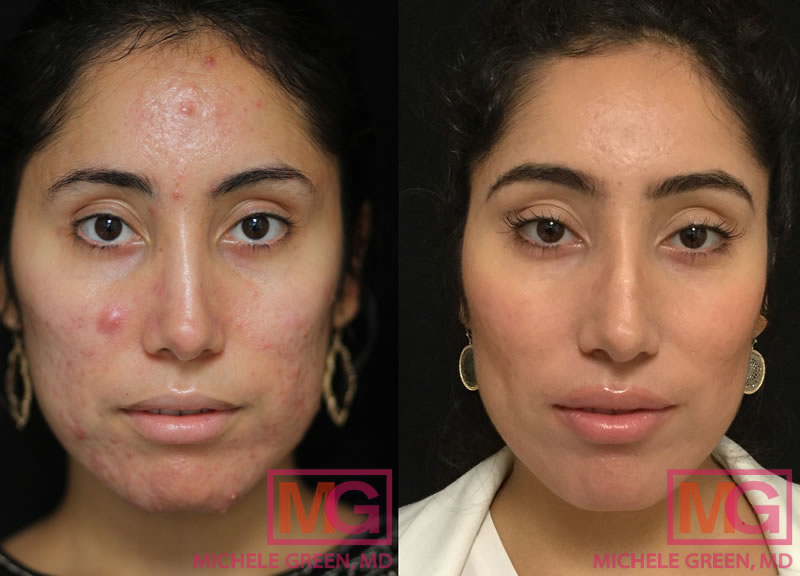Acne Scar Treatment NYC
View acne scar treatment options in NYC such as Vbeam® Laser, Fraxel® Dual laser and eMatrix
Acne scars form when inflammation associated with pimples causes damage to the underlying skin tissue. This inflammation causes damage to the skin’s collagen and affects its natural healing process. Collagen is a skin protein that provides it with structural support and a smooth, firm skin texture. Acne scars, whether they are hypertrophic or atrophic scars, can often be even more challenging to treat than the initial breakouts and, for many, cause feelings of self-consciousness or low self-esteem. No single acne scar treatment will be the best treatment option for everyone. A board-certified dermatologist, such as Dr. Michele Green in NYC, can develop customized acne scar treatment plans that meet the individual needs of each patient.
The best acne scar treatment is typically a combination approach designed specifically for the patient’s skin type and skin tone, as well as the severity and types of acne scars present. An expert like Dr. Green selects a unique combination of in-office treatment options and specially formulated skincare products to improve the appearance of acne scars successfully. Popular non-invasive acne scar treatment options include laser resurfacing, subcision with dermal fillers, microneedling, and chemical peels. Patients enjoy that these treatment options involve simple, straightforward procedures, require little to no downtime, and provide consistently stunning results. To ensure safety, efficacy, and optimal results, it is important to have acne scar treatments with an experienced board-certified dermatologist, such as Dr. Green.
Dr. Michele Green is an internationally renowned board-certified dermatologist with over two and a half decades of experience providing some of the world’s most discerning individuals with the best non-invasive treatment options, including acne scar treatments. Dr. Green takes a holistic approach to facial rejuvenation, customizing each patient’s treatment plan to suit their needs and aesthetic goals best. She is consistently identified as one of NYC’s best dermatologists by Castle Connolly, New York Magazine, the New York Times, and Super Doctors for her dedication to her patients and expertise. When you consult with her at her private dermatology office in NYC, Dr. Green will assess your acne scars and skin condition to create a personalized treatment plan that will leave you with a clear, smooth, beautiful complexion that lasts.
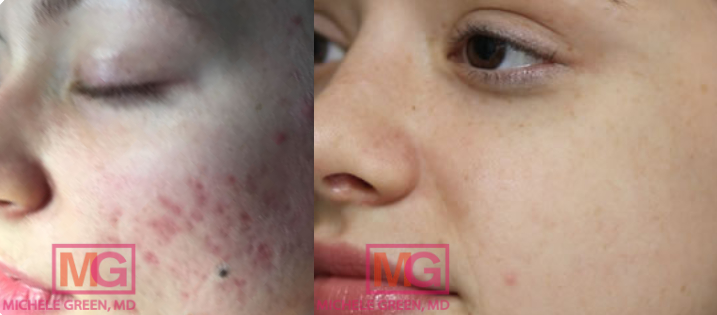
Acne scar treatment, VBeam and eMatrix
What is an acne scar?
An acne scar is evidence of permanent damage to the skin tissue caused by inflammation associated with acne blemishes. An acne scar occurs when an inflamed acne lesion becomes engorged with excess oil, sebum, dead skin cells, and bacteria. As the lesion swells, the inflammation causes trauma to the underlying skin tissue. This triggers the skin’s natural wound-healing response, which stimulates the production of collagen, a skin protein that contributes to a firm, smooth skin texture. When too little collagen is produced, a depressed scar develops. When excess collagen is made, a raised scar forms. The most common type of acne scar is a depressed scar, also known as an atrophic scar. While acne scars are permanent, their appearance can be significantly improved through various non-invasive treatments at Dr. Green’s private dermatology office in NYC.
Why does acne scar?
It is estimated that one out of every five patients with acne will develop acne scarring. Although there are some risk factors for acne scarring, those who will develop acne scars cannot be predicted. In some cases, there may be a genetic predisposition, such as a family history of cystic acne and acne scars. If inflammatory acne is not promptly treated, there is a greater chance that the acne lesions will form a spot. Picking, squeezing, or popping acne lesions and cysts causes more trauma to the skin and increases inflammation, increasing the likelihood of acne scar formation. If you are suffering from acne breakouts, it is best to consult an acne expert, such as Dr. Michele Green in NYC. Dr. Green is a world-renowned expert in cosmetic dermatology and will help you manage your acne breakouts to prevent acne scars best, as well as recommend the acne scar treatment options that will provide you with smooth, clear, healthy skin that lasts.
What are the different types of acne scars?
There are two main types of acne scars: atrophic and hypertrophic scars. Based on these two main types, acne scars can be divided into four subcategories. These subgroups include ice pick, boxcar, rolling, and raised spots. Acne scars can also vary in severity, ranging from macular to mild and moderate to severe.
Atrophic scars
Atrophic acne scars are the most common type of acne scar. Atrophic acne scars are depressions that develop when the skin’s natural wound-healing response produces insufficient new collagen. Inflammatory acne lesions, such as nodules and cysts, are the most likely to cause atrophic acne scars. Three different types of atrophic scars include icepick, rolling, and boxcar scars. Ice pick scars have a deep, narrow, v-shaped indentation and are the most difficult to treat due to their depth and shape. Rolling scars are shallow, uneven, and wave-like in appearance, seemingly “rolling” across the skin’s surface. Boxcar scars have a round or oval-shaped appearance, well-defined edges, and deep vertical sides.
Hypertrophic scars
Hypertrophic scars are thick, firm, raised scars that occur when the skin’s natural wound-healing response produces too much new collagen. Hypertrophic scars commonly develop as a healing response to a deeper wound and typically affect areas of the body such as the chest, back, shoulders, and jawline. If the raised, growth-like lumps of scar tissue are the same size as the initial wound, they are called hypertrophic scars. If the raised scars are larger than the initial wound and may continue to grow after healing, they are called keloid scars. Hypertrophic scars may eventually regress, whereas keloid scars do not.
What is post-inflammatory hyperpigmentation?
Post-Inflammatory hyperpigmentation (PIH) refers to the dark spots that may be left behind after an acne lesion, breakout, or other inflammatory skin condition such as eczema or psoriasis. Wounds from abrasions or scars from an injury can also heal with this type of discoloration. Depending on skin tone, the color of the dark spots associated with post-inflammatory hyperpigmentation may be brown, black, red, pink, or purple. During the natural healing process of the skin, there is potential that skin cells involved with healing the area are also contributing to the overproduction of melanin, leading to the development of the hyperpigmented regions of the skin. Although this hyperpigmentation may fade gradually over time, it’s more effective and efficient to have treatment with a board-certified dermatologist like Dr. Green in New York.
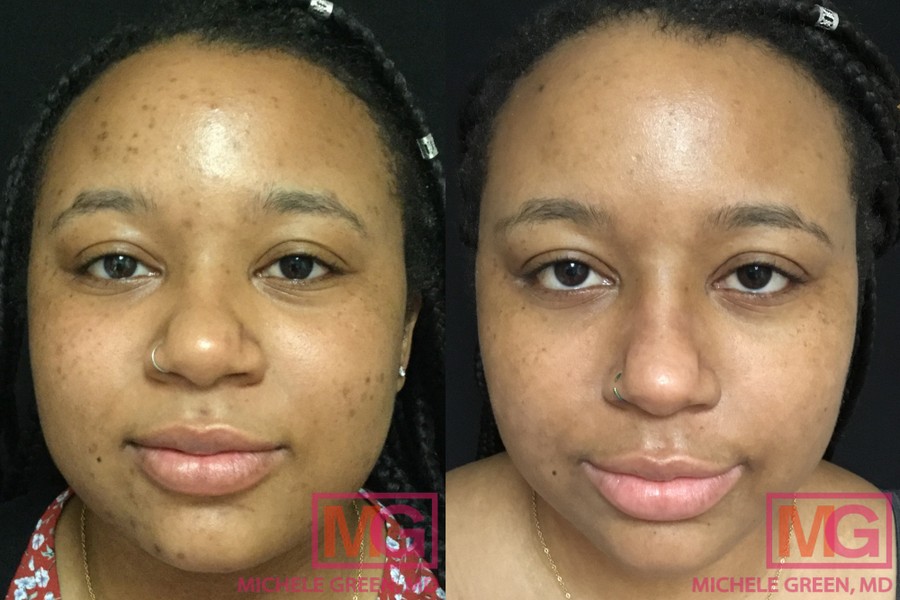
What is the best treatment for acne scarring?
There are a myriad of treatments available for acne scarring, including dermal fillers, lasers, microneedling, and chemical peels. An experienced and knowledgeable healthcare professional, such as board-certified dermatologist Dr. Green in NYC, selects the best treatments for each individual based on their skin type, skin tone, and the severity and different types of acne scars present. Typically, a combination approach is the most effective acne scar treatment plan, as patients can have a mixture of different acne scars on the skin.
Fraxel laser for acne scar treatment
Fraxel is a laser resurfacing procedure that utilizes fractional energy to stimulate new collagen production in the dermal layers of the skin. While the Fraxel laser has two different wavelength settings, Dr. Green utilizes the 1550nm wavelength setting to improve skin texture and reduce the appearance of acne scars. As a non-ablative and fractionated laser treatment, Fraxel creates microscopic laser columns that penetrate deep into the skin, leaving the top layer of skin intact and the skin surrounding the treated area untouched. Downtime is minimal, and patients typically experience redness and mild swelling that dissipate 48 hours after treatment. After the procedure, patients must adhere to strict sun adherence, as the laser increases sensitivity to the sun. Three to five Fraxel laser treatments are required to treat acne scars, each spaced approximately one month apart.
eMatrix laser and acne scar treatment
The eMatrix laser is a laser resurfacing treatment that relies on radiofrequency energy to stimulate new collagen production. The eMatrix laser is safe for all skin tones, making it an excellent treatment option for acne scars in Asian patients and those with darker skin tones. The heat energy from the laser penetrates the deeper layers of the dermis to leave the top layer of skin unharmed, allowing for a decreased risk of scarring or hyperpigmentation and minimal downtime – the healing process generally takes 48 hours, where patients may experience mild facial redness and swelling. Over time, as new collagen is formed, the laser treatment will produce a smoother skin texture and a more even skin tone with long-lasting rejuvenation results. For the best cosmetic results, Dr. Green recommends approximately five eMatrix laser treatments for atrophic scars, each spaced 4 to 6 weeks apart.
V-Beam laser and acne scars
The V-Beam laser is the gold standard for treating redness from acne and acne scars, including those associated with active acne lesions and post-inflammatory hyperpigmentation. This laser treatment utilizes pulsed dye technology to deliver a specific wavelength of light energy that targets exclusively red pigment, leaving surrounding skin cells untouched. The V-Beam laser has the added benefit of heating the deeper layers of the skin to stimulate new collagen production, creating a smoother skin texture while enhancing clarity. For maximum comfort during the procedure, the V-Beam laser is equipped with a patented Dynamic Cooling Device to emit bursts of cool air. There is no downtime, redness, or swelling with the V-Beam laser treatment. Most patients require 5 to 6 treatment sessions to achieve optimal rejuvenation results and diminish post-inflammatory hyperpigmentation.
Clear + Brilliant laser
Clear + Brilliant is a laser treatment option that can improve skin texture from acne scars as well as skin tone from sun damage or pigmentation. Touted as the “mini-Fraxel,” the Clear + Brilliant laser utilizes fractional laser energy to create thousands of microscopic injuries in the middle layers of the skin, triggering the skin’s natural healing processes, producing more significant skin cell turnover and new collagen. Clear + Brilliant laser treatment has no downtime and is recommended every 3 to 4 weeks, with an average of 5 treatments for acne scarring. There is no downtime or redness with the Clear + Brilliant laser. Immediately after your Clear + Brilliant laser treatment, the skin texture is treated with no recovery time at all. Sunblock and topical Vitamin C are advised to post-laser treatment to maximize the best cosmetic results.
Subcision with dermal fillers
Subcision with dermal fillers can effectively treat depressed scars, such as rolling and shallow boxcar scars, by breaking up the scar tissue and restoring lost volume to the area. During the subcision procedure, the needle is used to break up the fibrotic strands of scar tissue that tether the top layers of skin to the underlying tissue. Once the fibrotic bands of scar tissue are released, the skin is encouraged to produce new collagen in the treated area and heal with a smoother, more even skin texture. When subcision is performed with dermal fillers, the filler is then injected directly into the acne scar to replace lost volume and provide an even smoother skin surface. Dr. Green often performs subcision with Sculptra or hyaluronic acid dermal fillers to provide optimal cosmetic results with zero downtime. Dr. Green’s unique technique of subcison and injection will improve the appearance of scars even after one only treatment. Depending on the type and severity of your acne scars, Dr. Green may pair dermal filler treatment with a laser resurfacing treatment to provide you with the best cosmetic results.
Sculptra is a unique dermal filler in that it is composed of a substance called poly-L-lactic acid, which stimulates new collagen production in the treatment area once injected. Over time, as collagen is produced, the skin texture becomes smoother, reducing the appearance of depressed acne scars. Most patients require a short series of three Sculptra treatment sessions to achieve optimal results. It takes 4 to 6 weeks to see the effect of each Sculptra treatment, and results last up to two years. Most patients engage in regular follow-up treatment sessions to maintain ideal results. Dermal fillers such as Juvederm and Restylane are composed of hyaluronic acid, a naturally occurring substance in the skin that contributes to hydration and a youthful appearance. These dermal fillers are commonly used to restore the lost volume associated with acne scars for a smoother-looking appearance. Results with hyaluronic acid fillers are immediate and, depending on the type of HA filler used and the patient’s metabolism, can last anywhere between six to twelve months.
Microneedling for acne scar treatment
Microneedling, a popular cosmetic procedure also known as collagen induction therapy, uses a handheld device containing tiny needles to create controlled micro-injuries in the skin. This acne scar treatment stimulates the natural wound-healing process of the skin, which boosts the production of new collagen and elastin to smooth the skin and improve the appearance of acne scars. The microchannels created from the procedure also increase the absorption of topical serums, allowing for the microneedling procedure to be enhanced with platelet-rich plasma (PRP). PRP contains an abundance of proteins and epidermal growth factors that work to improve and accelerate the results observed from a microneedling treatment. As PRP is taken from a sample of the patient’s blood, it is 100% safe. Additionally, individuals with post-inflammatory hyperpigmentation can incorporate a depigmentation solution to enhance the microneedling procedure and improve areas of discoloration.
Vivace RF Microneedling
Vivace RF, a radiofrequency microneedling treatment, is another innovative treatment option for acne scarring. The microneedling process uses tiny, surgical-grade needles to create micro-injuries in the epidermis, stimulating the body’s wound-healing process to increase collagen production. At the same time, radiofrequency energy is delivered to the dermis layer of the skin and converted into heat energy, maximizing the stimulation of new collagen production. Vivace has adjustable needles that can be changed in increments of 0.1 millimeters, allowing for Dr. Green to produce an exact, controlled treatment that results in smoother, firmer, healthier skin and a more radiant, youthful complexion. There is zero downtime associated with the procedure. While the exact number of treatment sessions will vary based on the type and severity of your acne scars, Dr. Green recommends at least three treatment sessions spaced one month apart for optimal results.
Chemical peels
Chemical peels are resurfacing treatments that use chemo-exfoliation to accelerate skin cell turnover and trigger new collagen production, improving overall skin tone and texture. Many different kinds of chemical peels can serve as acne scar treatments, and each type uses an additional acid-based ingredient for exfoliating the skin’s surface. Chemical peels range from superficial (or light), medium depth, and deep chemical peels. To treat acne scars, Dr. Green will often opt for a superficial peel or a medium-depth peel, depending on the severity of the acne scarring. Generally, the best superficial chemical peels for acne consist of glycolic acid or light trichloroacetic acid (TCA). Medium-depth peels usually come with an acid solution containing 20% trichloroacetic acid (TCA) or higher. To treat acne scars, a series of 3 to 6 chemical peels is typically recommended, depending on the severity of the acne scars and hyperpigmentation.
Mesopeels are specially formulated chemical peels that are excellent for improving post-inflammatory hyperpigmentation from acne scars. They use chemo-exfoliation to increase collagen production, sloughing off dead, pigmented cells to bring new, healthy, even-toned cells to the skin’s surface. Mesopeels are associated with no downtime and are a safe and effective way to achieve an even-toned, radiant complexion. A series of three to six Mesopeels is often recommended for treating hyperpigmentation from acne scars.
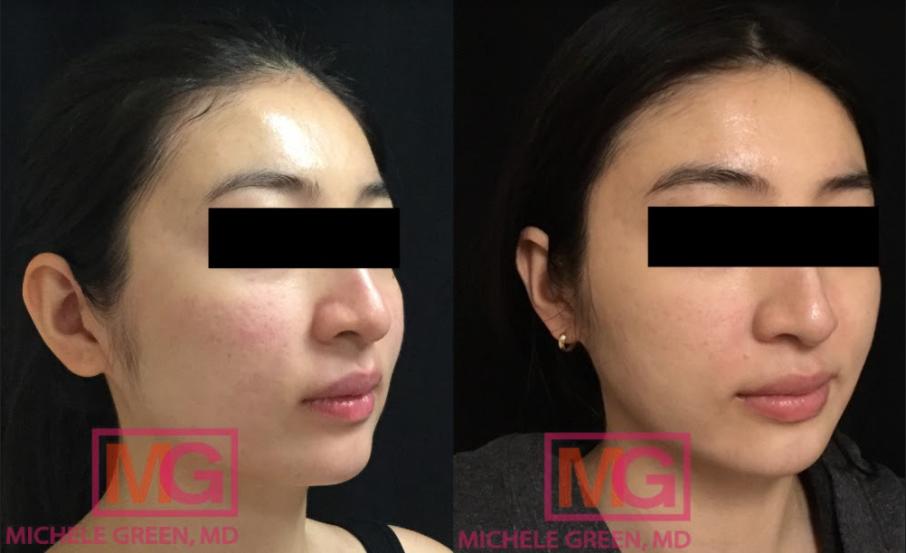
eMatrix 5 months 4 sessions
Other acne scar treatment options
Dermabrasion is a skin resurfacing cosmetic procedure that removes the entire top layer of skin with a specialized, abrasive tool. Several dermal layers of skin are also treated to stimulate new collagen production. The treatment area is numbed for the procedure, and there may be the option to be under general anesthesia, depending on the scope of treatment. Several weeks of downtime are associated with this treatment option, during which the treatment area may be red, blotchy, or swollen. Dermabrasion is not recommended for individuals with a history of keloid scarring or darker skin, as it may cause unwanted side effects, including hyperpigmentation and scarring.
Microdermabrasion stimulates new collagen production by exfoliating away the top layer of skin, smoothing out the skin texture. Traditional microdermabrasion is called crystal microdermabrasion. During a crystal microdermabrasion skin treatment, a specialized handpiece is used to gently spray tiny crystals (usually aluminum oxide or sodium bicarbonate) to sand away the outer layer of the skin. Diamond microdermabrasion entails directly applying a diamond-tipped handpiece to the skin’s surface to exfoliate the outer layer of the skin gently. This treatment option is painless, non-invasive, and does not involve downtime.
Kenalog injections are used to flatten raised scars, such as keloids and hypertrophic scars. These steroid injections are highly effective for shrinking active acne lesions and raised spots. Generally, intralesional kenalog injections are needed to flatten hypertrophic scars successfully.
Punch excision is a method for treating acne scarring in which a punch tool (regularly used for skin cancer biopsy) removes scar tissue. This scar revision treatment is a minimally invasive surgical procedure, ideal for deeper scars such as ice-pick scars. During the process, the punch tool removes the acne scar. After removing the spot, the wound left behind is closed with fine sutures or a skin graft. When the skin heals, a flatter, less noticeable fault replaces the acne scar.
Is acne scar laser treatment painful?
Not at all! For procedures such as laser resurfacing (Fraxel, eMatrix, Clear + Brilliant), dermal fillers, microneedling, and Vivace, Dr. Green will prescribe a topical numbing cream to be applied to the entire treatment area one hour before your appointment. Once you arrive at Dr. Green’s dermatology office in Manhattan’s Upper East Side neighborhood, the numbing cream will be removed and the skin sterilized to prepare for treatment. The topical numbing cream eliminates any potential discomfort associated with the procedure.
What is the hardest acne scar to remove?
Icepick acne scars are one of the hardest types of acne scars to treat due to their depth. Icepick scars create a V-shaped indentation that can extend deep into the skin. Typically, icepick acne scars require a combination approach for treatment and may involve more treatment sessions than other types of acne scarring. When you consult with Dr. Michele Green in her private NYC dermatology office, she will assess your type of acne scarring and design a customized treatment plan suited for your specific skin concerns. Some popular icepick acne scar treatment options include resurfacing laser treatments and chemical peels.
Which acne scars are easy to treat?
The most accessible type of acne scars to treat are rolling scars. Rolling scars are relatively shallow and soft, typically responding well to many different acne scar treatment options. Rolling scars often form due to long-term acne breakouts. Many patients have some unique combination of different kinds of acne scars, and successfully reducing the appearance of acne scars typically requires a combination treatment approach and a series of sessions with an experienced, board-certified dermatologist, such as Dr. Michele Green in NYC. Rolling scars are often treated with laser resurfacing, microneedling, and subcision with dermal fillers.
Is acne laser treatment safe?
Yes! The laser treatments offered at Dr. Green’s boutique dermatology office in NYC have been FDA-approved as safe and effective acne scar treatments. Laser resurfacing is considered one of the most effective acne scar treatments. It is essential, however, to consult and have laser treatment with an experienced board-certified dermatologist, such as Dr. Michele Green. Some laser treatments are unsafe for patients with darker skin, and unwanted side effects can include hyperpigmentation, hypopigmentation, and scarring. Unfortunately, this can occur when laser treatments are performed by inexperienced or unqualified technicians, such as in a Medspa setting. Dr. Green is an internationally renowned board-certified cosmetic dermatologist with over two and a half decades of experience treating acne scars in some of the world’s most discerning individuals. Dr. Green creates a safe and effective acne scar treatment plan for patients of every skin tone and skin type that provides optimal results.
Does insurance cover acne scar treatment?
While insurance often covers acne breakouts or treatments, it rarely covers acne scar treatment, as it is considered cosmetic rather than medically necessary. It is best to contact your insurance provider to determine which treatments may be substituted.
Can you 100% remove acne scars?
Unfortunately, no type of cosmetic treatment can 100% remove acne scars, as a scar results from permanent damage to skin tissue. However, it is possible to minimize the appearance of them so that they are no longer noticeable. Laser treatments, chemical peels, and microneedling all work to resurface the skin, inducing collagen production to smooth the skin and erase the appearance of atrophic acne scars from the skin’s surface. These treatments require a series of sessions to achieve smooth, radiant skin. Dermal fillers work to restore lost volume to depressed acne scars and minimize the appearance of atrophic scars. If dermal fillers are used to treat your atrophic scars, treatment will need to be performed once or twice a year to maintain optimal results, as dermal fillers are not permanent. When you consult with Dr. Green, she will assess your type of scarring and create a customized treatment plan suited to your skin concerns and aesthetic goals.
What clears acne scars fastest?
In-office treatments with a board-certified dermatologist, such as Dr. Green, are the fastest way to clear acne scars. While many over-the-counter products claim to treat acne scars, they only temporarily reduce the appearance of them. Instead, treatments such as the Fraxel laser, eMatrix laser, chemical peels, microneedling, and dermal fillers all work to treat acne scars and smooth the skin’s surface. Of these treatments, dermal fillers offer the fastest cosmetic results, as dermal fillers are able to provide immediate volume to depressed acne scars.
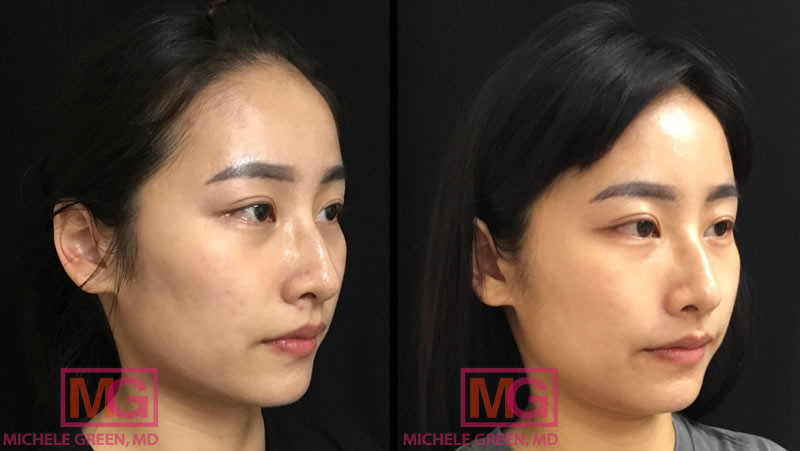
What is the most aggressive treatment for acne scars?
The most aggressive treatment for acne scars would be an ablative laser, such as the carbon dioxide (CO2) laser. The CO2 laser removes the entire top layer of the skin while simultaneously delivering heat energy to the dermal layer underneath. The CO2 laser stimulates new collagen production, smooths the skin, reduces the appearance of acne scarring, and improves skin tone and texture. Unlike non-ablative lasers, ablative lasers require significant downtime and can be very costly, which is why patients prefer non-ablative lasers such as the Fraxel to aggressive, ablative lasers such as the CO2 laser.
What is the best serum for acne scars?
While serums will not completely remove acne scars, they can help gradually reduce their appearance over time. Retinol is derived from vitamin A and is excellent for increasing collagen production to smooth the skin and create a more even skin texture and tone. Retinol can be prescribed by a dermatologist as tretinoin or found over the counter in various serums or creams. As retinol makes the skin sensitive to the sun, it is essential only to use retinol at night and practice proper sun protection by using a broad-spectrum sunscreen with a minimum SPF of 50.
Dark spots and discoloration that may be left on the skin after an acne lesion or breakout has healed are known as post-inflammatory hyperpigmentation (PIH). Post-inflammatory hyperpigmentation is not true acne scarring and typically resolves independently over time. However, it can take months or even years to diminish without intervention. Targeted over-the-counter skincare products, such as brightening serums, can help accelerate the process and create a more even skin tone. Serums containing active ingredients like vitamin C, azelaic acid, or alpha hydroxy acids (AHAs), such as glycolic acid and lactic acid, are great topical options for reducing post-inflammatory hyperpigmentation. Vitamin C increases cell turnover and has powerful antioxidant properties to slough off pigmented skin cells and brighten skin tone. Alpha hydroxy acids exfoliate discolored skin cells to reveal healthy, even-toned skin cells. Azelaic acid inhibits the activity of enzymes involved with melanin production. When you consult with board-certified dermatologist Dr. Michele Green at her private dermatology office in NYC, she will work with you to develop a customized skincare routine that includes the products best suited to your particular needs and goals.
Can retinol remove acne scars?
Retinol and retinoids are derived from vitamin A. Retinoids are known to reduce active pimples and can be beneficial for treating mild acne scars. These topical skincare products increase the skin cell turnover rate, encouraging the discovery of healthy, new skin cells. Retinoids also stimulate new collagen production, improving skin texture and tone. Retinoids are available over the counter and in prescription strength formulas. Retinoids can increase the photosensitivity of the skin, and it is essential to wear sunscreen with a minimum of SPF 50 daily while using retinoid products. While retinoids can significantly improve the appearance of enlarged pores, mild acne scars, and fine lines, most patients with moderate to severe acne scars require in-office treatment options to achieve a smoother complexion and even skin texture.
Does vitamin C help acne scars?
Vitamin C can help reduce the appearance of pigmented acne scars that result from post-inflammatory hyperpigmentation. Vitamin C is a powerful antioxidant that helps to increase skin cell renewal and collagen production. Over time, the vitamin C serum will slough off the dead, pigmented skin cells to bring new, healthy cells to the skin’s surface. Dr. Green’s MGSKINLABs, INC. Vita-C serum has been carefully developed to provide patients with a high concentration of vitamin C to reduce hyperpigmentation, boost collagen production, and smooth away fine lines and wrinkles.
Does Differin gel work for acne scars?
Differin gel is composed of 0.1% adapalene, a topical retinoid. Retinoids are vitamin A derivatives that work by increasing the rate of skin cell turnover, increasing collagen production, reducing oil production, and reducing the appearance of fine lines and wrinkles. While Differin gel is often used to clear and prevent acne breakouts, it can also help minimize the appearance of small, depressed acne scars and improve the appearance of textured skin. As retinoids can be irritating for some individuals, it is best to start using Differin gel once a week and slowly build up the frequency of usage to once a day to avoid any irritation to the skin.
How much does it cost to get rid of acne scars?
The cost of acne scar treatment will depend on several factors, such as the procedure performed and the provider’s geographic location. Multiple types of acne scars can typically be found on the face, and a combination of procedures is typically necessary for optimal treatment results. Acne scar treatments can range from $600 to $1500 per session, depending on the cosmetic procedure, and multiple treatment sessions may be necessary to reduce the appearance of acne scars. In addition, while it may be more cost-effective to go to a MedSpa, it is best to consult with a board-certified dermatologist such as Dr. Green to avoid any unwanted or adverse side effects.
Can acne scars be removed?
Unfortunately, many types of acne scars are permanent. While acne scar treatments can significantly improve their appearance, removing the acne scars completely is impossible. Reducing the appearance of atrophic and hypertrophic acne scars requires professional treatment, such as from board-certified dermatologist Dr. Michele Green in NYC. The cutting-edge, non-invasive acne scar treatment options at Dr. Green’s private dermatology office in New York City’s Upper East Side neighborhood provide consistently stunning cosmetic results without discomfort or downtime.
Are acne scars treatable?
Yes! Acne scars, including atrophic and hypertrophic scars, can be reduced with a variety of non-invasive treatment options available at Dr. Michele Green’s private dermatology office in Manhattan’s Upper East Side neighborhood. Acne scars can be a challenging skin condition to treat, and it is essential to consult an expert to guarantee optimal results and avoid unwanted potential side effects. It is essential that the acne scar treatments and skin care products that are incorporated into your treatment plan are suitable for your skin tone, skin type, and the types of acne scars present. Dr. Green has over two and a half decades of experience expertly treating acne scars in patients of every skin type and tone, and she will work with you to create a completely personalized plan to help you achieve long-lasting, healthy, smooth, clear, and radiant skin.
How to remove a face scar at home?
Face and acne scars cannot be completely removed at home. The scars left by acne lesions can be incredibly hard to treat; however, there are ways to minimize the appearance of them. Using targeted skincare products in tandem with cosmetic procedures can help enhance and accelerate the results of treatment. Patients with acne scars will often use retinol or salicylic acid to speed up cell turnover and increase collagen production. Patients with post-inflammatory hyperpigmentation can turn to alpha hydroxy acids, such as glycolic or lactic acid, vitamin C, or azelaic acid, to lighten dark acne scars for a more even skin tone. If you are interested in using skincare products at home to treat acne scars on the face, Dr. Green can work with you to create an individualized skin care routine best suited to your specific skin concerns, acne scar types and severity, and aesthetic goals.
Are acne scars noticeable?
Acne scars are most noticeable to those who are affected by them. For many, acne scars induce feelings of self-consciousness and low self-esteem. Various non-invasive acne scar treatments available at Dr. Green’s private dermatology office can significantly reduce the appearance of acne scars, making them much less noticeable.
Does microneedling help acne scars?
Yes! Microneedling, sometimes referred to as collagen induction therapy, is an excellent way to treat acne scars. The microneedling procedure uses tiny, surgical-grade needles to create microchannels in the skin, stimulating collagen production and smoothing the skin to reduce the appearance of acne scars. Since the microchannels promote rapid absorption of topical products, the microneedling procedure can be enhanced with platelet-rich plasma (PRP) to accelerate the healing process or with a depigmentation serum to treat post-inflammatory hyperpigmentation.
Why do acne scars form?
Acne scars form when inflammation associated with an acne lesion causes irreparable damage to the underlying skin tissue. During the natural wound-healing process, collagen production occurs. When insufficient collagen is produced, depressed acne scars form. When excess collagen is produced, raised scars form. Dark spots that are left behind on the skin following a breakout are referred to as post-inflammatory hyperpigmentation. These pigmented lesions are not acne scars and may resolve independently over time. However, they can be lightened more quickly with the right combination of in-office treatment options and specially formulated skin care products, recommended by Dr. Green, depending on your skin tone and skin type. Some individuals are more prone to acne scarring than others. There is thought to be a genetic component to acne scarring, as those with a family history of acne scars are more likely to develop them than those without. While there are some risk factors for acne scarring, it can not be predicted who will grow acne scars. This is why treating acne breakouts, especially cystic acne, is critical as soon as possible.
Does acne scarring heal?
It is estimated that one in every five individuals who experience breakouts will develop acne scars. While dark spots associated with post-inflammatory hyperpigmentation will likely fade over time, atrophic and hypertrophic scars are usually permanent. It is possible, however, to reduce the appearance of acne scars with various cosmetic treatment options available at Dr. Michele Green’s private dermatology office in Manhattan’s Upper East Side neighborhood. Dr. Green is a board-certified dermatologist with over two and a half decades of experience providing some of the world’s most discerning individuals with the best personalized non-invasive acne scar treatment plans. Dr. Green will collect a thorough medical history, review any previous cosmetic treatments, and physically assess the treatment area to determine which combination of cosmetic procedures will provide you with long-lasting, smooth, clear, healthy-looking skin.
Do acne scars stay forever?
Acne scars form when inflammation associated with active lesions causes permanent damage to the underlying skin tissue. Unless acne scars are treated by an experienced board-certified dermatologist, such as Dr. Green in NYC, they are unlikely to resolve independently. Luckily, many non-invasive treatment options are available to improve acne scars’ appearance. At Dr. Green’s boutique dermatology office in NYC’s Upper East Side, she offers a wide range of acne scar treatments, including chemical peels, subcision with dermal fillers, laser resurfacing, and Microneedling. A dermatologist customizes the best types of acne scar treatments to suit your skin type, the types of acne scars present, your skin tone, and your overall aesthetic goals. With over 25 years of experience at the forefront of cosmetic dermatology, Dr. Green has the expertise to create a completely personalized treatment plan for safely and effectively reducing your acne scars to provide a healthy, clear complexion that lasts.
Are acne scars attractive?
Acne scars can be a devastating reminder of a painful breakout and, for many, induce feelings of self-consciousness or low self-esteem. The presence of acne and acne scars don’t necessarily define attractiveness, but individuals with acne scars are less likely to feel confident. Various acne scar treatment options, including Microneedling, chemical peels, laser resurfacing, and subcision with dermal fillers, can be performed to reduce the appearance of acne scars and restore self-confidence. Consulting with an acne scar expert, such as board-certified dermatologist Dr. Michele Green, is the best way to develop an acne scar treatment plan that will work best for your particular needs and overall aesthetic goals.
Are acne scars permanent?
Unfortunately, acne scars are permanent. Acne scar treatments are incredibly effective at minimizing the appearance of acne scars, but they can never be 100% removed. Depressed acne scars form when insufficient collagen is formed during the wound-healing process. Many acne scar treatments work by replenishing lost collagen, but as we age, we continue to lose and break down collagen, causing acne scars to become more apparent, even after having acne scar treatment. For this reason, most patients engage in maintenance treatment sessions as needed. When you consult board-certified dermatologist Dr. Michele Green in NYC, she will work with you to establish a customized acne scar treatment plan and timeline that caters to your particular needs and aesthetic goals.
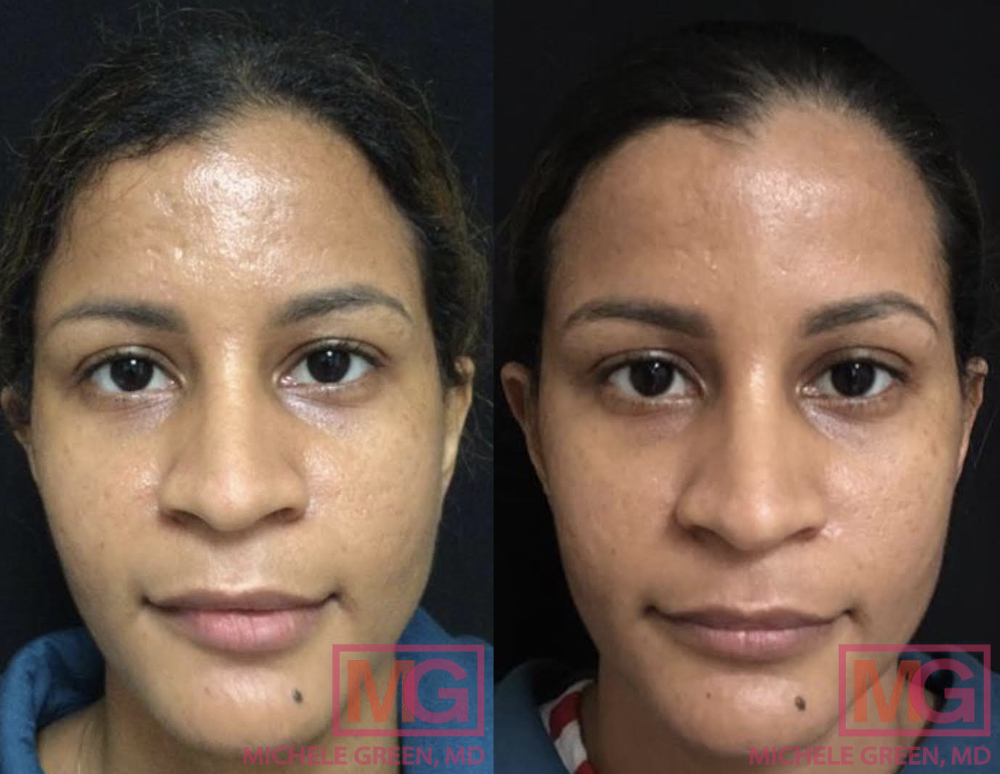
What are Grade 1, 2, 3, 4 acne scars?
Acne scars can be classified as Grade 1, 2, 3, or 4, increasing in severity of the acne scar. Grade 1 acne scars are macular, flat scars typically with red pigmentation. Grade 2 acne scars are those that can easily be camouflaged by facial hair or makeup. Grade 3 acne scars are classified as moderate scarring that is not easily covered by facial hair or makeup and can be seen at a distance. Grade 4 acne scars, the most severe type of acne scars, typically cannot be well covered by facial hair or makeup and are very evident at even a large distance.
Can salicylic acid remove acne scars?
Salicylic acid is an excellent topical ingredient for treating acne scars. Salicylic acid is a beta hydroxy acid that gently exfoliates the skin, removing dead skin cells, excess oil, and impurities from pores. In addition, salicylic acid can reduce inflammation and promote collagen production for an overall smoother complexion. Skincare products with salicylic acid are especially great for treating post-inflammatory hyperpigmentation, as they work to slough off dead pigmented cells to bring new healthy cells to the skin’s surface. Salicylic acid can be found in various cleansers, serums, creams, and chemical peels. It is important to note that salicylic acid alone will not be able to remove your acne scars completely or may not work on deeper scars such as icepick scars; it is best to use salicylic acid in conjunction with in-office treatments for maximum cosmetic results.
How to fade acne scars naturally?
While there has not been much research into natural remedies, people commonly use aloe vera, rosehip oil, tea tree oil, and turmeric to fade acne scars. Both aloe vera and rosehip oil contain anti-inflammatory properties to reduce redness and inflammation. Tea tree oil contains antimicrobial as well as anti-inflammatory properties to reduce swelling and calm the skin. Turmeric has skin-lightening properties to fade dark acne scars from post-inflammatory hyperpigmentation and contains anti-inflammatory properties to reduce scarring.
It is important to remember that “natural” is not always safe for the skin. Natural ingredients can still cause irritation on the skin, especially for individuals with existing skin conditions such as eczema, rosacea, or psoriasis. If you are interested in using natural remedies or ingredients to fade your acne scars, it is best to conduct a test spot to ensure no irritation occurs. If you are unsure about what products to use for acne scar treatment, consult with a board-certified dermatologist such as Dr. Green, who can create a customized skincare routine for your specific acne scars and skin concerns.
Can stem cells cure acne scars?
Stem cells are a new, innovative treatment in cosmetic dermatology that is being incorporated to treat a wide variety of skin conditions, including acne scars. Stem cells are cells that have not been differentiated or assigned a specific function. In theory, stem cells can differentiate into fibroblasts, the cell type responsible for making collagen, to increase collagen production and accelerate healing. These stem cells can be derived from various types of tissues, including bone marrow, umbilical cord blood, and adipose tissue. While some clinics have incorporated stem cells into laser resurfacing treatments or microneedling with PRP with some success, more research needs to be conducted to determine its safety and efficacy in acne scar treatments.
How to remove scar marks on face?
Thanks to developments in cosmetic dermatology, there are a myriad of different ways to remove scar marks on the face. The exact treatment for your scar marks will depend on your skin tone and the type and severity of your acne scars. Some individuals may be well suited for Fraxel laser resurfacing, while others may be better suited for eMatrix laser resurfacing. For deep acne scars, subcision with dermal fillers can help to smooth out indentations. For dark acne scars due to post-inflammatory hyperpigmentation, a Cosmelan or Mesopeel will be best.
How to remove acne scars naturally?
Unfortunately, there is no natural way to remove acne scars. Acne scars develop as a result of too much or too little collagen being produced during the wound-healing process after an acne lesion. While some natural remedies may be able to help reduce inflammation or redness associated with acne scars, no natural ingredient will be able to penetrate into the epidermis or dermis to affect the skin on a cellular level. Especially for individuals with deeper acne scars, such as icepick scars, having cosmetic treatments with a board-certified dermatologist such as Dr. Green is the most effective way to remove acne scars for a clear, even-textured complexion.
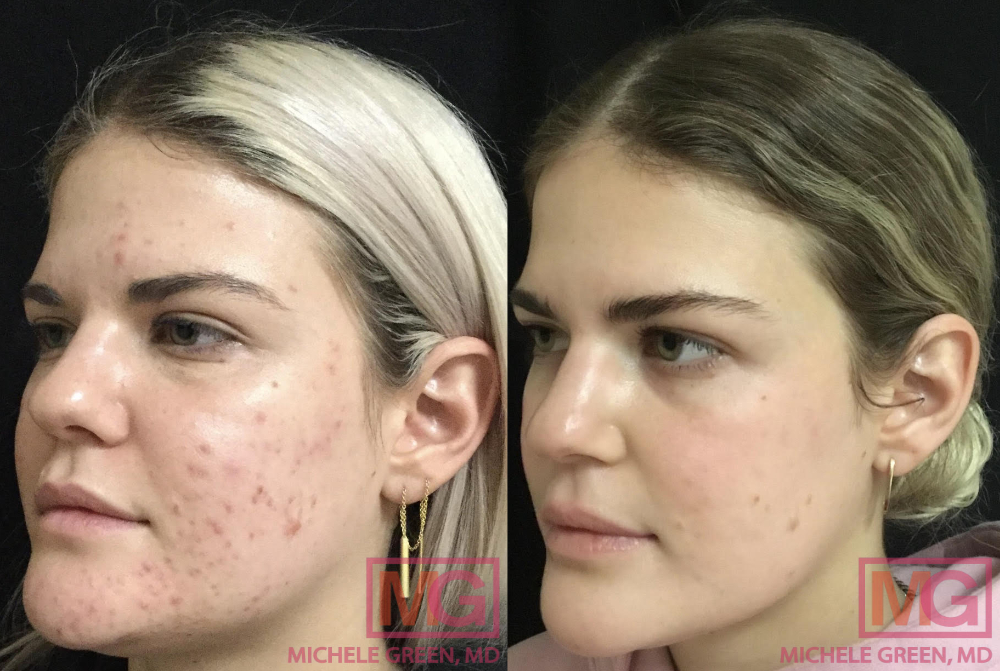
Is acne scar treatment worth it?
Absolutely! For many, the appearance of acne scars can induce feelings of self-consciousness and low self-esteem. There are many types of acne scar treatment options, and Dr. Green customizes each patient’s plan to address their specific concerns best. When you consult with Dr. Green at her private dermatology office in Manhattan’s Upper East Side, she will work with you to determine which acne scar treatments are suited to your skin tone, skin type, and the types of acne scars present. Although it can be a process to treat acne scars, most patients agree that it is worth it to achieve a smoother, brighter, healthier-looking complexion that lasts.
How to get started with acne scar treatment at Dr. Green’s NYC dermatology office
Acne scars can be challenging to treat and, for many, may induce feelings of self-consciousness or low self-esteem. Luckily, many non-invasive acne scar treatment options, such as laser resurfacing, microneedling, dermal fillers, and chemical peels, can reduce the appearance of acne scars. These treatments are associated with little to no downtime or side effects, making them a safe and effective option for treating acne scars. Most patients have several types of acne scars on their skin, requiring a unique combination treatment approach to reduce their appearance successfully. An expert in cosmetic dermatology, Dr. Green can work with you to create a customized acne scar treatment plan to address the types of acne scars you have and provide you with a healthy, smooth, clear, beautiful complexion that lasts.
Dr. Michele Green is an internationally renowned board-certified dermatologist with over two and half decades of experience providing some of the world’s most discerning individuals with the best non-invasive treatment options for acne scars, including Fraxel, eMatrix, dermal fillers, and microneedling. She is consistently identified as one of New York City’s best dermatologists by Castle Connolly, Super Doctors, and New York Magazine for her dedication to her patients and expertise. Dr. Green takes a holistic approach and embraces a less-is-more philosophy regarding rejuvenation, customizing each patient’s treatment plan to suit their specific concerns and personal aesthetic goals best. If you’re ready to get started with your personalized acne scar treatment, schedule a consultation with Dr. Green by contacting us online or calling the NYC office at 212-535-3088.
Which Acne Scar Treatment option is right for me?
Find out more about acne treatment options available to you
 212-535-3088
212-535-3088 